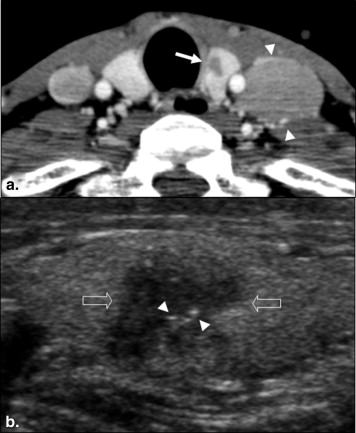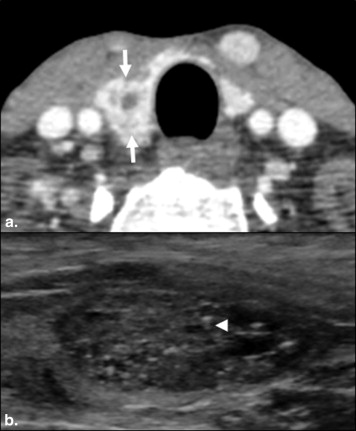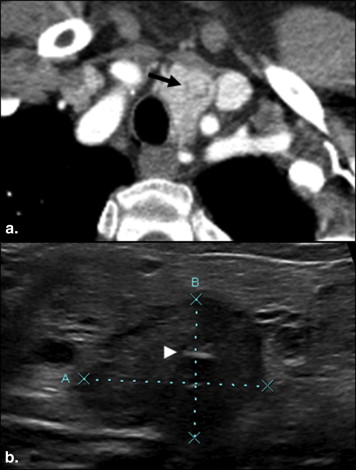Rationale and Objectives
There are no definitive guidelines for the management of incidental thyroid lesions on computed tomography (CT). The objectives of our study were to assess the association between CT and ultrasound (US) characteristics of thyroid lesions and identify CT predictors of benignity or malignancy.
Materials and Methods
Two hundred fifty-nine patients who had undergone both CT of the chest or neck and thyroid US had at least one thyroid lesion visible on CT; both incidentally detected and palpable or symptomatic lesions were included. The CT and US examinations were retrospectively reviewed and lesions characterized. Pathologic results from fine-needle aspiration (FNA) and surgical excision were used to classify lesions as benign or malignant. Thyroid lesions without pathologic correlation were classified as either benign or indeterminate based on US evaluation. Lesions that were cystic, predominantly cystic, solid and cystic with features consistent with a colloid nodule, or stable for at least 1 year were considered benign. Fisher exact tests, Spearman correlations, and logistic regression models were used to evaluate the associations between CT and US characteristics and CT predictors of benignity or malignancy. Multivariable logistic regression analyses were performed to examine the joint associations between the CT features and sonographically assessed benignity.
Results
Of 259 patients, 168 (64.9%) patients had incidentally detected thyroid lesions, 49 (18.9%) patients had palpable/symptomatic lesions, and 116 (44.8%) patients underwent surgical resection and/or FNA biopsy. The malignancy prevalence was 1.8% (3 of 168) for incidental thyroid lesions and 10.2% (5 of 49) for palpable/symptomatic lesions. The malignancy prevalence of incidental lesions initially detected on CT was 1.6% (2 of 125). Of the 143 patients without pathologic data, 58 (40.6%) were classified as benign and 85 (59.4%) were categorized as indeterminate based on US evaluation. Statistically significant associations were found between CT and US with regard to lesion number, dominant lesion size, lesion consistency/composition, and associated calcifications. No CT characteristics of thyroid lesions predicted malignancy. However, there were statistically significant associations on multivariate analysis between indeterminate/benign nodules and CT characteristics of smaller lesion size, lower mean attenuation, and homogeneous composition.
Conclusions
Recommending sonographic evaluation of all incidentally detected thyroid lesions is likely not the appropriate strategy, given the high prevalence of thyroid incidentalomas, low probability of malignancy, and cost effectiveness of workup. Small, homogeneous, low-attenuation lesions have a high probability of being benign.
Incidental lesions of the thyroid are commonly encountered in computed tomography (CT) imaging of the neck and chest. Two separate studies reported a prevalence of up to 17% . There is considerable variability in the manner of reporting incidentally detected thyroid lesions, including which follow-up recommendations are provided . This variability is largely due to the fact that there are no established guidelines for the management of incidental thyroid lesions discovered on CT.
The reported malignancy prevalence of incidental thyroid nodules detected on CT is not insignificant, ranging from 9% to 11% . However, papillary carcinoma, which accounts for nearly 90% of thyroid cancer cases, has an excellent prognosis . In fact, despite increased diagnosis and resection of papillary cancers over the past several decades, there has been essentially no improvement in cancer-specific mortality . Micropapillary carcinomas measuring <10 mm in diameter have an even better prognosis, with one study reporting no cancer-related deaths during a 10-year surveillance period . Thus, although incidental thyroid lesions may harbor malignancy, workup of all thyroid incidentalomas, particularly when small, may result in overdiagnosis and overtreatment of indolent tumors.
Get Radiology Tree app to read full this article<
Materials and Methods
Get Radiology Tree app to read full this article<
Table 1
Patient Demographics
Characteristic Data ( n = 259) Number of females 171 (66.0) Mean age, years 61 ± 14 (range, 18–96) Thyroid lesion presentation Incidental 168 (64.9) Initially detected on CT 125 (74.4) Initially detected on US 34 (20.2) Initially detected on MR 4 (2.4) Initially detected on PET 5 (3.0) Palpable/symptomatic 49 (18.9) Partial thyroidectomy follow-up 2 (0.8) Unknown 38 (14.7) Not seen on ultrasound 2 (0.8)
CT, computed tomography; MR, magnetic resonance; PET, positron emission tomography; US, ultrasound.
Get Radiology Tree app to read full this article<
Get Radiology Tree app to read full this article<
Get Radiology Tree app to read full this article<
Get Radiology Tree app to read full this article<
Get Radiology Tree app to read full this article<
Get Radiology Tree app to read full this article<
Results
Get Radiology Tree app to read full this article<
Table 2
Pathologic Results of Thyroid Lesions
Result ( n = 116) Number (%) Incidental lesion FNA biopsy ( n = 61) Nondiagnostic (Bethesda I) 5 (8.2) Benign (Bethesda II) 53 (86.9) Follicular lesion (Bethesda III) 2 (3.3) Follicular neoplasm (Bethesda IV) 1 (1.6) Surgical excision ( n = 9) Multinodular goiter 3 (33.3) Follicular hyperplasia 2 (22.2) Follicular adenoma 2 (22.2) Papillary carcinoma 2 (22.2) Palpable/symptomatic lesion FNA biopsy ( n = 20) Nondiagnostic (Bethesda I) 2 (10.0) Benign (Bethesda II) 18 (90.0) Surgical excision ( n = 8) Colloid nodule 1 (12.5) Multinodular goiter 2 (25.0) Papillary carcinoma 3 (37.5) Medullary carcinoma 1 (12.5) Anaplastic carcinoma 1 (12.5) Other lesion FNA biopsy ( n = 16) Benign (Bethesda II) 16 (100.0) Surgical excision ( n = 2) Colloid nodule 1 (50.0) Papillary carcinoma 1 (50.0)
FNA, fine-needle aspiration.
Bethesda II and III lesions were considered benign, whereas Bethesda IV lesion was considered malignant.
Get Radiology Tree app to read full this article<
Get Radiology Tree app to read full this article<
Agreement Between CT and US Characteristics
Get Radiology Tree app to read full this article<
Table 3
Characteristics of Thyroid Lesions on CT
CT Characteristic ( n = 259 Patients) Number (%) Number of lesions 1 117 (45.2) 2 44 (17.0) 3 22 (8.5) 4 8 (3.1) ≥5 68 (26.3) Size of dominant lesion (mm) 1–4 19 (7.3) 5–9 69 (26.6) 10–19 95 (36.7) 20–100 76 (29.3) Consistency Heterogeneous 165 (63.7) Homogeneous 94 (36.3) Mean attenuation with contrast (HU, n = 174) <50 29 (16.7) 50–99 48 (27.6) 100–199 83 (47.7) >200 14 (8.0) Mean attenuation without contrast (HU, n = 85) <50 42 (49.4) 50–99 38 (44.7) 100–199 4 (4.7) >200 1 (1.2) Associated calcifications ∗ Absent 203 (78.4) Present 56 (21.6) Punctate 10 (25.7) Coarse 39 (15.2) Peripheral 17 (6.6)
CT, computed tomography; HU, Hounsfield units.
Get Radiology Tree app to read full this article<
Get Radiology Tree app to read full this article<
Get Radiology Tree app to read full this article<
Table 4
Comparison of CT Features of Benign Versus Malignant Thyroid Lesions
Parameter Malignant (n = 9) Benign (n = 100)P Value Age, years 65.0 62.1 .53 ∗ Sex .62 † Female 6 (66.7) 67 (67.0) Male 3 (33.3) 33 (33.0) Number of lesions .99 ‡ 1 4 (44.4) 36 (36.0) 2 0 19 (19.0) 3 2 (22.2) 8 (8.0) 4 0 5 (5.0) ≥5 3 (30.3) 32 (32.0) Size of lesion (mm) .62 ‡ 1–4 0 0 5–9 4 (44.4) 17 (17.0) 10–19 0 42 (42.0) 20–100 5 (55.6) 41 (41.0) Lesion consistency .43 † Heterogeneous 6 (66.6) 78 (78.0) Homogeneous 3 (33.3) 22 (22.0) Mean lesion attenuation with contrast (HU)n = 7n = 70 .14 ‡ <50 2 (28.6) 7 (10.0) 50–99 2 (28.6) 19 (27.1) 100–199 3 (42.9) 36 (51.4) >200 0 8 (11.4) Mean lesion attenuation without contrast (HU)n = 2n = 30 .99 ‡ <50 1 (50.0) 16 (53.3) 50–99 1 (50.0) 13 (43.3) 100–199 0 1 (3.3) >200 0 0 Associated calcifications_n_ = 9n = 100 .51 † Present 1 (11.1) 18 (18.0) Coarse and peripheral 1 (11.1) 1 (1.0) Coarse 0 11 (11.0) Punctate 0 4 (4.0) Peripheral 0 2 (2.0)
CT, computed tomography; HU, Hounsfield units.
Get Radiology Tree app to read full this article<
Get Radiology Tree app to read full this article<
Get Radiology Tree app to read full this article<
Get Radiology Tree app to read full this article<
Number of Lesions on CT
Get Radiology Tree app to read full this article<
Lesion Size on CT
Get Radiology Tree app to read full this article<
Lesion Consistency on CT
Get Radiology Tree app to read full this article<
Lesion Attenuation on CT
Get Radiology Tree app to read full this article<
Lesion Calcifications on CT
Get Radiology Tree app to read full this article<
Get Radiology Tree app to read full this article<
Discussion
Get Radiology Tree app to read full this article<
Get Radiology Tree app to read full this article<
Get Radiology Tree app to read full this article<
Get Radiology Tree app to read full this article<
Get Radiology Tree app to read full this article<
Get Radiology Tree app to read full this article<
Get Radiology Tree app to read full this article<
Get Radiology Tree app to read full this article<
Get Radiology Tree app to read full this article<
Get Radiology Tree app to read full this article<
Get Radiology Tree app to read full this article<
References
1. Yousem D.M., Huang T., Loevner L.A., et. al.: Clinical and economic impact of incidental thyroid lesions found with CT and MR. Am J Neuroradiol 1997; 18: pp. 1423-1428.
2. Yoon D.Y., Chang S.K., Choi C.S., et. al.: The prevalence and significance of incidental thyroid nodules identified on computed tomography. J Comput Assist Tomogr 2008; 32: pp. 810-815.
3. Hoang J.K., Riofrio A., Bashir M.R., et. al.: High variability in radiologists’ reporting practices for incidental thyroid nodules detected on CT and MRI. Am J Neuroradiol 2014; 35: pp. 1190-1194.
4. Lehnert B.E., Sandstrom C.K., Gross J.A., et. al.: Variability in management recommendations for incidental thyroid nodules detected on CT of the cervical spine in the emergency department. J Am Coll Radiol 2014; 11: pp. 681-685.
5. Shetty S.K., Maher M.M., Hahn P.F., et. al.: Significance of incidental thyroid lesions detected on CT: correlation among CT, sonography, and pathology. Am J Roentgenol 2006; 187: pp. 1349-1356.
6. Davies L., Welch H.G.: Current thyroid cancer trends in the United States. JAMA Otolaryngol Head Neck Surg 2014; 140: pp. 317-322.
7. Hoang J.K., Choudhury K.R., Eastwood J.D., et. al.: An exponential growth in incidence of thyroid cancer: trends and impact of CT imaging. Am J Neuroradiol 2014; 35: pp. 778-783.
8. Ito Y., Miyauchi A., Inoue H., et. al.: An observational trial for papillary thyroid microcarcinoma in Japanese patients. World J Surg 2010; 34: pp. 28-35.
9. Frates M.C., Benson C.B., Charboneau J.W., et. al.: Management of thyroid nodules detected at US: Society of Radiologists in US consensus conference statement. Radiology 2005; 237: pp. 794-800.
10. Cooper D.S., Doherty G.M., Haugen B.R., et. al.: Revised American Thyroid Association management guidelines for patients with thyroid nodules and differentiated thyroid cancer. Thyroid 2009; 19: pp. 1167-1214.
11. Ahmed S., Horton K.M., Jeffrey R.B., et. al.: Incidental thyroid nodules on chest CT: review of the literature and management suggestions. Am J Roentgenol 2010; 195: pp. 1066-1071.
12. Cibas E.S., Ali S.Z.: The Bethesda system for reporting thyroid cytopathology. Am J Clin Pathol 2009; 132: pp. 658-665.
13. Ahuja A., Chick W., King W., et. al.: Clinical significance of the comet-tail artifact in thyroid US. J Clin Ultrasound 1996; 24: pp. 129-133.
14. Kim E.K., Park C.S., Chung W.Y., et. al.: New sonographic criteria for recommending fine-needle aspiration biopsy of nonpalpable solid nodules of the thyroid. Am J Roentgenol 2002; 178: pp. 687-691.
15. Papini E., Guglielmi R., Bianchini A., et. al.: Risk of malignancy in nonpalpable thyroid nodules: predictive value of ultrasound and color-Doppler features. J Clin Endocrinol Metab 2002; 87: pp. 1941-1946.
16. Nguyen X.V., Choudhury K.R., Eastwood J.D., et. al.: Incidental thyroid nodules on CT: evaluation of 2 risk-categorization methods for work-up of nodules. Am J Neuroradiol 2013; 34: pp. 1812-1817.
17. Hobbs H.A., Bahl M., Nelson R.C., et. al.: Incidental thyroid nodules detected at imaging: can diagnostic workup be reduced by use of the Society of Radiologists in Ultrasound recommendations and the three-tiered system?. Am J Roentgenol 2014; 202: pp. 18-24.


